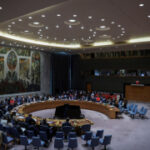EXPLAINER
Iran remains the US’s adversary in the Middle East since the 1979 Islamic revolution led by Ayatollah Ruhollah Khomeini.
Published On 23 Jun 2025
United States-Iran tensions have surged to the highest point in decades after President Donald Trump on Sunday ordered direct strikes that he said “obliterated” key nuclear facilities across the Middle Eastern country.
Iran remains the biggest adversary of the US in the region since the 1979 Islamic revolution led by Ayatollah Ruhollah Khomeini toppled pro-Western Mohammad Reza Pahlavi. Since then, the two nations have sparred over a multitude of issues, including Iran’s nuclear ambitions, Iran’s backing of proxies in the region, and US political interference.
Israel, which has long considered Iran a threat, launched unprecedented strikes across Iran last week after accusing the country of developing nuclear weapons. Israeli claims have not been backed by any credible proof, but Trump dragged the US into the war following the Israeli strikes.
On Sunday, the US directly hit Iran in what the Trump administration called a highly sophisticated covert attack that involved more than 125 US aircraft and 75 precision bombs. Washington said it “devastated” Iran’s nuclear sites, but Tehran has warned it will retaliate.

Here’s a timeline of US-Iran relations since 1953:
- (1953) US-backed coup and reinstallation of the shah: Tensions initially began brewing over the democratically elected Iranian Prime Minister Mohammad Mosaddegh’s efforts to nationalise the Anglo-Iranian Oil Company (now BP). The British colonial power controlled the majority stake in the joint-venture company since oil was discovered in the early 1900s. Mosaddegh’s moves to nationalise the company after his 1951 election angered the British. The US’s Central Intelligence Agency supported the United Kingdom in engineering a coup and backing once-deposed monarch, Pahlavi, back into power as shah.
- (1957) Atoms for Peace: The shah’s ambitions for a nuclear-powered Iran gained support from the US and other Western allies. Both countries signed a nuclear agreement for the civilian use of nuclear power as part of then-US President Dwight D Eisenhower’s Atoms for Peace programme. A decade later, the US provided Iran with a nuclear reactor and uranium to fuel it. The nuclear collaboration forms the basis for the current nuclear question.
- (1979) Islamic revolution: While relations between Tehran and Washington flourished, Iranians groaned under the dictatorship of the shah and resisted the perceived overreach of Western influence on their business. Revolutionary protests began rocking the country in late 1978 and forced the shah to flee in January 1979. Exiled Islamic scholar Ayatollah Ruhollah Khomeini returned to rule the new Islamic republic.
- (1980) US cuts diplomatic ties: Following the US’s move to admit the shah for cancer treatment after his exile, Iranian students broke into the US embassy in Tehran and kidnapped 52 Americans for 444 days. Washington cut off diplomatic ties and imposed sanctions on the country. The shah died in exile.
- (1980-88) US backs Iraqi invasion: Following Iraq’s invasion of Iran under Saddam Hussein, who was eager to push back against Khomeini’s ideology, the US sided with Iraq, deepening tensions between the two nations




